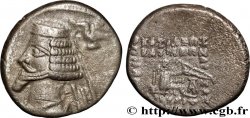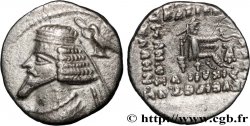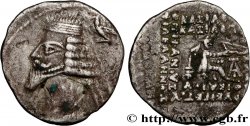bgr_929538 - PARTIA - REINO DE PARTIA - PHRAATES IV Tétradrachme
No disponible.
Artículo vendido en nuestra tienda (2024)
Precio : 225.00 €
Artículo vendido en nuestra tienda (2024)
Precio : 225.00 €
Tipo : Tétradrachme
Fecha: c. 35-24 AC.
Nombre del taller / ciudad: Séleucie du Tigre
Metal: vellón
Diámetro: 27,5 mm
Eje de acuñación: 12 h.
Peso: 9,67 g.
Grado de rareza: R1
Comentarios sobre el estado de conservación:
Monnaie centrée. Joli buste de Phraates. Usure régulière. Patine grise
N° en los catálogos de referencia :
Anverso
Titulatura del anverso: ANÉPIGRAPHE.
Descripción del anverso: Buste de Phraates IV à gauche, tête nue avec un bandeau triple, sans nœud qui tombe derrière la tête, la chevelure crantée couvrant l’oreille, la barbe courte et pointue.
Reverso
Descripción del reverso: Phraates IV assis à droite sur un trône à dossier tourné à droite, recevant une palme de Tyché debout à gauche dans le champ à droite, drapée, tenant une corne d’abondance.
Leyenda del reverso: BASILEWS/ BASILEWN/ ARSAKOU// EUERGETOU/ DIKAIOU// EPIFANOUS/ FILLENHNOS
Traducción del reverso: (Roi des rois Arsace, bienfaiteur, juste, glorieux, philhellène).
Comentario
L’ère parthe commençait en 312 avant J.-C., reposant sur l’ère séleucide et la dédicace de Séleucie du Tigre par son fondateur, Séleucus Nicator. Le début de l’année parthe était fixée au mois d’octobre (Dios) et basé sur un calendrier lunaire avec un mois intercalaire. Malheureusement, l’année et le mois ne sont pas visibles sur notre exemplaire.
The Parthian era began in 312 BC, building on the Seleucid era and the dedication of Seleucia Tigris by its founder, Seleucus Nicator. The start of the Parthian year was fixed in the month of October (Dios) and based on a lunar calendar with an intercalary month. Unfortunately, the year and month are not visible on our example
The Parthian era began in 312 BC, building on the Seleucid era and the dedication of Seleucia Tigris by its founder, Seleucus Nicator. The start of the Parthian year was fixed in the month of October (Dios) and based on a lunar calendar with an intercalary month. Unfortunately, the year and month are not visible on our example








 Informar de un error
Informar de un error Imprimir la página
Imprimir la página Comparte mi selección
Comparte mi selección Haz una pregunta
Haz una pregunta Consignar / vender
Consignar / vender
 Descriptivo
Descriptivo










